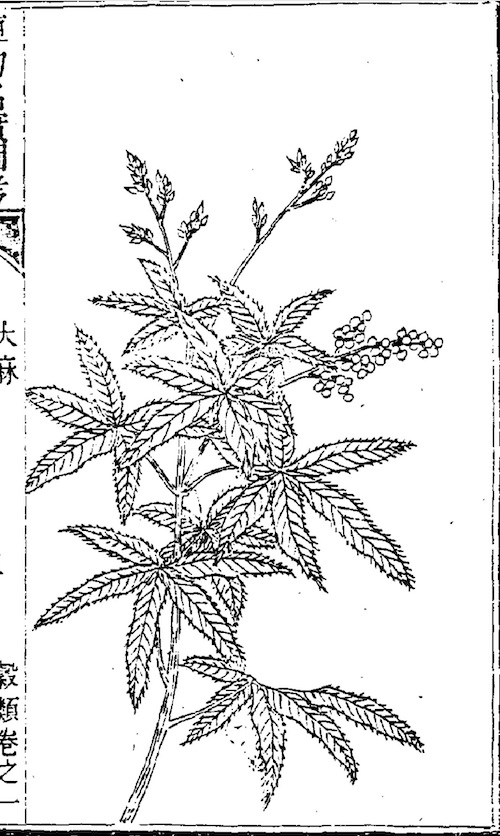Zhiwu mingshi tukao 植物名實圖考 is a book on flowers and non-flowering plants compiled during the late Qing period 清 (1644-1911) by Wu Qijun 吳其濬 (1789-1847), courtesy name Yuezhai 瀹齋, style Yulou Nong 雩婁農, from Gushi 固始, Henan.
Wu obtained the jinshi degree in 1816 and was appointed senior compiler (xiuzhuan 修撰) of the Hanlin Academy 翰林院 and then provincial education commissioner (xuezheng 學政) of Hubei and Jiangxi. Being made Academician in the Grand Secretariat (neige xueshi 内閣學士), Wu was promoted to the post of governor (xunfu 巡撫) of Hunan, then Zhejiang, Yunnan and finally of Shanxi, before he became governor-general (zongdu 總督) of Hu-Guang and then of Yunnan. Wu then returned to the central government, where he was Left Vice Minister of War (bingbu zuo shilang 兵部左侍郎), and then Right Vice Minister of Revenue (hubu you shilang 户部右侍郎) and concurrently Supervisory Manager of Coinage (zhangguan qianfatang shiwu 掌管錢法堂事務). His experience in the administration of monetary copper can be seen in his treatises Diannan kuangchang tulüe 滇南礦廠圖略. He also wrote a kind of travel handbook for Yunnan called Dianxing jicheng ji 滇行紀程集.
Wu's book aimed to clarify the confusion of botanical names in older texts. There were cases where the same name was used for different plants or the same plant was given different or wrong designations. Wu put a lot of effort into investigating such matters, inspecting plants by himself, checking descriptions in all types of texts, and adding realistic illustrations to help his readers.
The whole book consists of a first part of 38 juan in length, an enlarged part of 22 juan (Zhiwu mingshi tukao changbian 植物名實圖考長編). The core part includes the descriptions of 1,714 plants, which is even 500 more than the famous botanical book Bencao gangmu 本草綱目 by Li Shizhen 李時珍 (1518-1593) from the Ming period 明 (1368-1644). It is divided into 12 chapters according to the nature of plants, and presents information on grains (Gulei 穀類), legumes (Shulei 蔬類), herbs growing in mountains (Shancao 山草), plants growing in rocky areas (Shicao 石草), marshland herbs (Xicao 隰草), water herbs (Shuicao 水草), creeping herbs (Mancao 蔓草), odorous herbs (Fangcao 芳草), poisonous herbs (Ducao 毒草), "beautiful and fragrant" herbs (Qunfang 群芳), fruits (Guolei 果類), and economic trees (Mulei 木類). The structure of the book thus follows the traditional pattern of the materia medica (bencao 本草) texts, all the more as Wu does not just provide information on the physical appearance of plants but also on their medical use. Wu's scholarly work is of extraordinary diligence and reliability by quoting and indicating his sources exactly, providing analytical information, and drawing scientific conclusions. His more than 1,800 drawings are much better and more realistic than those of older books. The supplement (Changbian) is arranged in the same manner and presents quotations from ancient books on 838 plants. It is valuable for its commentaries on botanical classics like Shaoyaopu 芍藥譜, Tongpu 桐譜, Julu 橘録, Canshu 蠶書, Xunpu 菌譜, Jupu 菊譜, Mudanpu 牡丹譜 or Lizhipu 荔枝譜.
 |
 |
Images and description of sesame (called huma 胡麻, but usually zhima 芝麻) and Cannabis sativa (dama 大麻). 1848 Shanxi Taiyuan Fushu 山西太原府署 (Prefectural gvt. of Taiyuan) edition. |
|
Wu's book was extensively used by Emil W. Bretschneider (1833-1901) for his book Botanicon Sinicum: Notes on Chinese Botany from Native and Western Sources (1882-1893). In Japan, the book was received and printed in 1890.
The text must have been finished before 1846. It was printed a year later – after Wu's passing away - by Lu Yinggu 陸應谷, and in 1880 by the Junwen Shuju 濬文書局 in Shanxi. The Commercial Press (Shangwu Yinshuguan 商務印書館) reprinted the book in 1918. The whole text was reproduced in the late 1950s, yet the Changbian part was brought to the market two years later than the first part. The text is included in the series Wanyou wenku 萬有文庫.